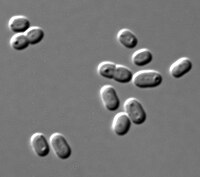
Photo from wikipedia
Marine picophytoplankton have crucial ecological value and make an important contribution to marine primary productivity. While biomass of phytoplankton in general is projected to decline as a result of global… Click to show full abstract
Marine picophytoplankton have crucial ecological value and make an important contribution to marine primary productivity. While biomass of phytoplankton in general is projected to decline as a result of global warming, picophytoplankton will likely dominate in the future oceans due to their growth advantages in an oligotrophic environment. To better understand the biography of picophytoplankton, we undertook a comprehensive study of the distribution patterns of picophytoplankton, carbon biomass, and Chl a concentrations, etc. based on large-scale sampling in the tropical Western Pacific Ocean. In terms of cellular abundance, Prochlorococcus was the most abundant group (averaging [1.03 ± 0.40] × 104 cells/mL), followed by Synechococcus (averaging [1.31 ± 1.22] × 103 cells/mL) and then picoeucaryote (averaging [4.83 ± 2.84] × 102 cells/mL). The picophytoplankton size-fractionated chlorophyll a (Pico-Chl a) accounted for about 30% of the total Chl a, with Prochlorococcus and picoeukaryotes contributing 41 and 35%, respectively, of the Pico-Chl a-normalized carbon biomass, indicating the ecological importance of picophytoplankton as the primary producers. In terms of biogeographic distribution, the picophytoplankton communities exhibited contrasting patterns. The surface distribution of Prochlorococcus and Synechococcus was concentrated in the low latitude of the 142°E section, while picoeucaryote was more abundant near the 130°E and equator sections. Synechococcus was higher in the shallow layer at 25 m, and it was extremely tolerant of high-light irradiation, while Prochlorococcus and picoeucaryote were distributed in the deep Chlorophyll maximum layer (DCM) (about 100 m). From the carbon-to-Chlorophyll a ratios, which was derived from Prochlorococcus and picoeucaryote population groups, we found that the ratio varied widely, from 0.19 to 75.56, and was highest at the depth of 200 m. Of these, Prochlorococcus had an important contribution. The correlation analysis of environmental factors showed that Prochlorococcus, Synechococcus, and picoeucaryote were negatively correlated with nutrient concentration. We concluded that Prochlorococcus group was dominant in the WPO, both in abundance and biomass, and the various abiotic factors such as temperature, salinity, and nutrient concentrations were closely correlated with the spatial variation in the picophytoplankton community. These findings aid our understanding of how contrasting environmental conditions influence picophytoplankton community and the importance of picophytoplankton in contributing the carbon pool in the oligotrophic ocean.
Journal Title: Frontiers in Microbiology
Year Published: 2022
Link to full text (if available)
Share on Social Media: Sign Up to like & get
recommendations!